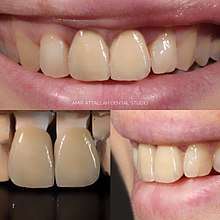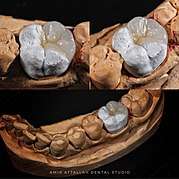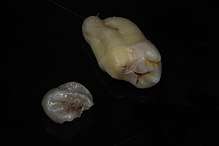Fixed prosthodontics
Fixed prosthodontics is the area of prosthodontics focused on permanently attached (fixed) dental prostheses. Such dental restorations, also referred to as indirect restorations, include crowns, bridges (fixed dentures), inlays, onlays, and veneers. Prosthodontists are specialist dentists who have undertaken training recognized by academic institutions in this field. Fixed prosthodontics can be used to restore single or multiple teeth, spanning areas where teeth have been lost. In general, the main advantages of fixed prosthodontics when compared to direct restorations is the superior strength when used in large restorations, and the ability to create an aesthetic looking tooth. As with any dental restoration, principles used to determine the appropriate restoration involves consideration of the materials to be used, extent of tooth destruction, orientation and location of tooth, and condition of neighboring teeth.
Preparation techniques
Preparation of a tooth for a crown involves the irreversible removal of a significant amount of tooth structure. All restorations possess compromised structural and functional integrity when compared to healthy, natural tooth structure. Thus, if not indicated as desirable by an oral health-care professional, the crowning of a tooth would most likely be contraindicated. It should be evident, though, that dentists trained at different institutions in different eras and in different countries might very well possess different methods of treatment planning and case selection, resulting is somewhat diverse recommendations for treatment.
Traditionally more than one visit is required to complete crown and bridge work, and the additional time required for the procedure can be a disadvantage; the increased benefits of such a restoration, however, will generally offset these considerations.
Dimensions of preparation
When preparing a tooth for a crown, the preparation should, ideally, exist entirely in enamel. As elaborated on below, the amount of tooth structure required to be removed will depend on the material(s) being used to restore the tooth. If the tooth is to be restored with a full gold crown, the restoration need only be .5 mm in thickness (as gold is very strong), and therefore, a minimum of only .5 mm of space needs to be made for the crown to be placed. If porcelain is to be applied to the gold crown, an additional minimum of 1 mm of tooth structure needs to be removed to allow for a sufficient thickness of the porcelain to be applied, thus bringing the total tooth reduction to minimally 1.5 mm. For porcelain or ceramic crowns the amount of tooth reduction is 2 mm. For metal it is 1 mm.
If there is not enough tooth structure to properly retain the prosthetic crown, the tooth requires a build-up material. This can be accomplished with a pin-retained direct restoration, such as amalgam or a resin like fluorocore, or in more severe cases, may require a post and core. Should the tooth require a post and core, endodontic therapy would then be indicated, as the post descends into the devitalized root canal for added retention. If the tooth, because of its relative lack of exposed tooth structure, also requires crown lengthening, the total combined time, effort and cost of the various procedures, together with the decreased prognosis because of the combined inherent failure rates of each procedure, might make it more reasonable to have the tooth extracted and opt to have an implant placed.
Taper
The prepared tooth also needs to possess a certain degree of taper to allow for the restoration to be properly placed on the tooth. Fundamentally, there can be no undercuts on the surface of the prepared tooth, as the restoration will not be able to be removed from the die, let alone fit on the tooth (see explanation of lost-wax technique below for understanding of the processes involved in crown fabrication). At the same time, though, too much taper will severely limit the grip that the crown has while on the prepared tooth, thus contributing to failure of the restoration. Generally, 3° of taper around the entire circumference of the prepared tooth, giving a combined taper of 6° at any given sagittal section through the prepared tooth, is appropriate to both allow the crown to fit yet provide enough grip.
Margin
The most coronal position of untouched tooth structure (that is, the continual line of original, undrilled tooth structure at or near the gumline) is referred to as the margin. This margin will be the future continual line of tooth-to-restoration contact, and should be a smooth, well-defined delineation so that the restoration, no matter how it is fabricated, can be properly adapted and not allow for any openings visible to the naked eye, however slight. An acceptable distance from tooth margin to restoration margin is anywhere from 40-100 nm. However, the R.V. Tucker method of gold inlay and onlay restoration produces tooth-to-restoration adaptation of potentially only 2 nm, confirmed by scanning electron microscopy; this is less than the diameter of a single bacterium.
Naturally, the tooth-to-restoration margin is an unsightly thing to have exposed on the visible surface of a tooth when the tooth exists in the esthetic zone of the smile. In these areas, the dentist would like to place the margin as far apical (towards the root tip of the tooth) as possible, even below the gum line. While there is no issue, per se, with placing the margin at the gumline, problems may arise when placing the margin too subgingivally (below the gumline). First, there might be issues in terms of capturing the margin in an impression to make the stone model of the prepared tooth (see stone model replication of tooth in photographs, above). Secondly, there is the seriously important issue of biologic width. Biologic width is the mandatory distance to be left between the height of the alveolar bone and the margin of the restoration, and if this distance is violated because the margin is placed too subgingivally, serious repercussions may follow. In situations where the margin cannot be placed apically enough to provide for proper retention of the prosthetic crown on the prepared tooth structure, the tooth or teeth involved should undergo a crown lengthening procedure.
There are a number of different types of margins that can be placed for restoration with a crown. There is the chamfer, which is popular with full gold restorations, which effectively removed the smallest amount of tooth structure. There is also a shoulder, which, while removing slightly more tooth structure, serves to allow for a thickness of the restoration material, necessary when applying porcelain to a PFM coping or when restoring with an all-ceramic crown (see below for elaboration on various types of crowns and their materials). When using a shoulder preparation, the dentist is urged to add a bevel; the shoulder-bevel margin serves to effectively decrease the tooth-to-restoration distance upon final cementation of the restoration.
Ferrule effect
The single most important consideration when restoring with a crown is, undeniably, the incorporation of the ferrule effect. As with the bristles of a broom, which are grasped by a ferrule when attached to the broomstick, the crown should envelop a certain height of tooth structure to properly protect the tooth from fracture after being prepared for a crown. This has been established through multiple experiments as a mandatory continuous circumferential height of 2 mm; any less provides for a significantly higher failure rate of endodontically-treated crown-restored teeth. When a tooth is not endodontically treated, the remaining tooth structure will invariably provide the 2-mm height necessary for a ferrule, but endodontically treated teeth are notoriously decayed and are often missing significant solid tooth structure. Contrary to popular belief, endodontically treated teeth are not brittle after being devitalized according to the following study -CM Sedglay & Messer 1992 Journal of Endodontics. Contrary to what some dentists believe, a bevel is not at all suitable for implementing the ferrule effect, and beveled tooth structure may not be included in the 2 mm of required tooth structure for a ferrule.
Restoration types



Crown
A crown is used to cover a tooth and may be commonly referred to as a "cap." Traditionally, the teeth to be crowned are prepared by a dentist, and records are given to a dental technician to construct the prosthesis. The records include models, which are replicas of a patient's teeth, and the impressions used to make these models. There are many different methods of crown fabrication, each using a different material. Some methods are quite similar, and utilize either very similar or identical materials. Crowns may be made of gold or other similar metals, porcelain, or a combination of the two. Crowns made of Zirkonia Oxide are being made more popular due to its high translucency and durability as opposed to chipping disadvantages of porcelain crowns.
Bridge
A bridge is used to span, or bridge, an edentulous area (space where teeth are missing), usually by connecting to fixed restorations on adjacent teeth. The teeth used to support the bridge are called abutments. A bridge may also refer to a single-piece multiple unit fixed partial denture (numerous single-unit crowns either cast or fused together). The part of the bridge which replaces a missing tooth and attaches to the abutments is known as a "pontic." For multiple missing teeth, some cases may have several pontics.
Inlay
An inlay is a restoration which lies within the confines of the cusps. These restorations are considered to be more conservative than onlays or crowns because less tooth structure is removed in preparation for the restoration. They are usually used when tooth destruction is less than half the distance between cusp tips.
Onlay
An onlay is a method of tooth restoration, which covers, protects or reinforces one or more cusps. Onlays are methods for restoring teeth in an indirect way. Onlays are often used when teeth present extensive destruction due to caries or to trauma.
Veneer
A veneer is a thin layer of restorative material placed over a tooth surface, either to improve the esthetics of a tooth, or to restore a damaged tooth surface. Materials used for veneers may include composite and porcelain. In some cases, removal of tooth structure is needed to provide sufficient space for the veneer, whereas sometimes a restoration may be bonded to a tooth without preparation of the tooth.
Dental Implants
Screw-retained restoration
The main benefit of screw retention is the retrievability of the restoration.
This does not exist in common fixed prosthodontics on teeth. As a result, any complication with the restoration is easily addressed. The screw retained restoration can be easily removed which allows to repair or examine the soft tissue and direct visualization of the implant. This also negates the need to remake the restoration if an abutment screw or prosthetic screw loosens. eliminates the potential complications associated with excess residual cement – often difficult to completely remove with a cement retained crown, The screw retained restoration lacks glue and hence is more preferable for the health of the gingiva and the implant.
Cement-retained restoration
The cement retained option provides the assurance of maximum esthetics but has two downsides
The first being the restoration is cemented to an abutment that is screw retained. If the abutment screw becomes loose the final restoration cannot be removed without destroying it, in many instances. This results in a remake and increased cost. The second is excess cement along the implant surface that can potentially act as medium for colonization by bacteria and can jeopardize the attachment. This will ultimately result in implant failure. In certain instances cement retention is the only option.
See also
- Dentures
- Dental restoration
- Dental materials